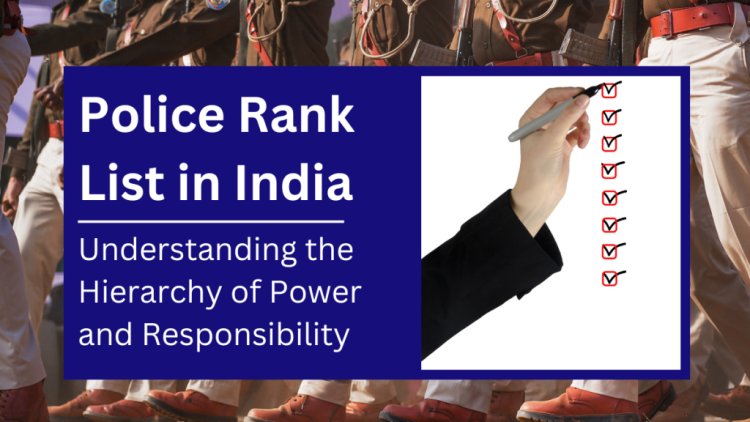Police Rank List and Salary Structure in India
Discover the complete Police Rank List and salary structure in India. Learn about roles, responsibilities, pay scales, and benefits of officers at different levels in this detailed guide.
Share this Post to earn Money ( Upto ₹100 per 1000 Views )

The police force in India plays a crucial role in maintaining law and order, ensuring public safety, and enforcing the law. It is a hierarchical organization, and the ranks within the force are clearly defined. Understanding the Police Rank List and their respective salary structure helps citizens appreciate the roles and responsibilities of officers at different levels. This article provides a detailed overview of the rank system in Indian police services and the corresponding pay scales.
Overview of the Police Rank System in India
The Indian police hierarchy follows a structured pattern, with ranks assigned based on seniority, responsibility, and experience. The ranks are broadly divided into two categories:
Gazetted Officers: These officers belong to higher ranks, starting from Deputy Superintendent of Police (DSP) to the Director General of Police (DGP). They are appointed through state or central services exams.
Non-Gazetted Officers: These include ranks like constables, head constables, and sub-inspectors. They form the backbone of the police force, handling day-to-day operations and field duties.
Police Rank List in India (Top to Bottom)
Here is the complete Police Rank List in descending order:
1. Director General of Police (DGP)
Responsibilities: The DGP is the head of the police force in a state or union territory. They oversee the entire police department and formulate policies to improve law enforcement.
Position: Equivalent to a Secretary to the Government of India in terms of rank.
2. Additional Director General of Police (ADGP)
Responsibilities: The ADGP assists the DGP and oversees specific departments like law and order, training, or crime investigation.
3. Inspector General of Police (IGP)
Responsibilities: The IGP supervises police operations in a specific zone, which may cover multiple districts within a state.
4. Deputy Inspector General of Police (DIG)
Responsibilities: The DIG reports to the IGP and manages police operations at a range or division level.
5. Superintendent of Police (SP)
Responsibilities: The SP is in charge of a district, managing law enforcement and administrative responsibilities.
6. Additional Superintendent of Police (ASP)
Responsibilities: The ASP supports the SP in managing district-level law enforcement tasks.
7. Deputy Superintendent of Police (DSP)
Responsibilities: DSP is an entry-level gazetted rank. They oversee police operations in subdivisions or circles.
8. Inspector
Responsibilities: Inspectors head police stations and investigate serious cases like murder and robbery.
9. Sub-Inspector (SI)
Responsibilities: SIs are in charge of smaller police units and report to Inspectors. They conduct investigations and manage field operations.
10. Assistant Sub-Inspector (ASI)
Responsibilities: The ASI assists SIs in day-to-day operations, often handling administrative tasks at police stations.
11. Head Constable
Responsibilities: Head Constables supervise constables and act as a link between the senior officers and field personnel.
12. Constable
Responsibilities: Constables are the entry-level officers responsible for patrolling, maintaining public order, and assisting in investigations.
Salary Structure of Police Ranks in India
The salary of police officers in India varies depending on their rank, years of service, and the state or union territory they serve in. Salaries are determined by the 7th Pay Commission, and officers also receive allowances like housing, travel, medical benefits, and risk allowances. Below is the rank-wise salary structure:
1. Director General of Police (DGP)
Pay Scale: ₹2,25,000 (fixed) per month
Allowances: Housing, official vehicle, and travel expenses.
2. Additional Director General of Police (ADGP)
Pay Scale: ₹2,05,400 - ₹2,24,400 per month
Allowances: Dearness allowance (DA), travel allowance, and more.
3. Inspector General of Police (IGP)
Pay Scale: ₹1,44,200 - ₹2,18,200 per month
Allowances: Includes housing and transport allowances.
4. Deputy Inspector General of Police (DIG)
Pay Scale: ₹1,31,100 - ₹2,16,600 per month
Allowances: Dearness allowance, risk allowance.
5. Superintendent of Police (SP)
Pay Scale: ₹78,800 - ₹2,09,200 per month
Allowances: Includes official vehicle and housing benefits.
6. Additional Superintendent of Police (ASP)
Pay Scale: ₹67,700 - ₹2,08,700 per month
Allowances: Dearness allowance and medical benefits.
7. Deputy Superintendent of Police (DSP)
Pay Scale: ₹56,100 - ₹1,77,500 per month
Allowances: Housing, travel, and medical benefits.
8. Inspector
Pay Scale: ₹44,900 - ₹1,42,400 per month
Allowances: Includes risk and travel allowances.
9. Sub-Inspector (SI)
Pay Scale: ₹35,400 - ₹1,12,400 per month
Allowances: Dearness allowance and other benefits.
10. Assistant Sub-Inspector (ASI)
Pay Scale: ₹29,200 - ₹92,300 per month
Allowances: Includes risk and travel allowances.
11. Head Constable
Pay Scale: ₹25,500 - ₹81,100 per month
Allowances: Housing and transport benefits.
12. Constable
Pay Scale: ₹21,700 - ₹69,100 per month
Allowances: Includes risk allowance and medical benefits.
Factors Affecting Salary and Allowances
State Variations: Salaries and allowances may differ slightly based on state policies.
Experience and Service: Officers with more years of service may receive higher pay and additional benefits.
Special Allowances: Officers in high-risk zones or special branches like anti-terrorism squads receive extra risk allowances.
Additional Benefits for Police Officers
Apart from the basic salary, police officers are entitled to several benefits:
Housing Allowance: Subsidized housing or housing rent allowance.
Medical Benefits: Free or subsidized healthcare for officers and their families.
Retirement Benefits: Includes pension schemes and gratuity.
Travel Allowances: Cover transportation costs for official duties.
Education Support: Scholarships for officers’ children.
Conclusion
The Police Rank List and salary structure in India reflect the responsibilities and risks associated with law enforcement. From constables to the Director General of Police, every rank has a well-defined role and compensation package. While the job comes with challenges, the benefits and respect associated with serving the nation make it a fulfilling career. Understanding the rank system and salary details can help aspiring candidates and citizens appreciate the dedication of our police force.
















